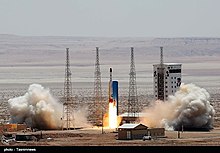
Back سيمرغ (صاروخ) Arabic Simorgh (Rakete) German ماهوارهبر سیمرغ Persian Simorgh (fusée) French סימורג (משגר לוויינים) HE Simorgh (roket) ID Simorgh (lanciatore) Italian シムルグ (ロケット) Japanese 시모르그 (로켓) Korean Simorgh (foguete) Portuguese
 The Simorgh satellite launch vehicle launching on its first orbital test flight on 27 July 2017. | |
| Function | Small-lift space launch vehicle |
|---|---|
| Country of origin | |
| Size | |
| Height | 25.9 m (85 ft) |
| Diameter | 2.4 m (7 ft 10 in) first stage, 1.5 m (4 ft 11 in) second stage |
| Mass | 87 t (192,000 lb) |
| Stages | 2 (optional 3rd stage) |
| Capacity | |
| Payload to LEO 200 km | |
| Mass | 800 kg (1,800 lb)[1] |
| Payload to LEO 500 km | |
| Mass | 250 kg (550 lb)[2] |
| Payload to LEO 500 km (with Saman-1) | |
| Mass | 400 kg (880 lb) |
| Associated rockets | |
| Family | Derived from Safir |
| Launch history | |
| Status | Active |
| Launch sites | Imam Khomeini Space Launch Terminal |
| Total launches | 7 or 8 (1 suborbital) |
| Success(es) | 3 (1 suborbital) |
| Failure(s) | 3 or 4 |
| First flight | 19 April 2016 (suborbital) 27 July 2017 (orbital) |
| Last flight | 6 December 2024 (orbital) |
| First stage | |
| Height | 17.8 m |
| Diameter | 2.4 m |
| Powered by | 4 × modified Shahab-3 engines[3] + 4 verniers |
| Maximum thrust | 1,590 kN (360,000 lbf) |
| Burn time | 120 seconds |
| Propellant | N2O4 / UDMH |
| Second stage | |
| Diameter | 1.5 m |
| Powered by | 4 × LRE-4 (R-27 Zyb vernier engines) |
| Maximum thrust | 71.6 kN (16,100 lbf) |
| Burn time | 320 seconds |
| Propellant | N2O4 / UDMH |
| Third stage (Optional) | |
| Powered by | Saman-1 |
| Maximum thrust | 13 kN (2,900 lbf) |
| Burn time | 40 seconds |
| Propellant | Solid |
Simorgh (Persian: ماهوارهبر سیمرغ, Simurgh), also called Safir-2, is an Iranian expendable launch vehicle under development.[4][5] It is the successor of the Safir, Iran's first space launch vehicle.[6] Its mission is to carry heavier satellites into higher orbit than Safir.[7]
The project was unveiled by Iranian President Mahmoud Ahmadinejad on 3 February 2010, as part of celebrations of the first anniversary of the launch of Omid, the first indigenously launched Iranian satellite,[8] and was launched for the first time on 19 April 2016.[9]
- ^ "برنامه ثریا ۱۵ خرداد ۱۴۰۱". telewebion.com (in Persian). 2022-06-05. Retrieved 2022-06-25.
- ^ "Iran launches Simorgh satellite carrier from Imam Khomeini Space Center". Mehr News Agency. 2017-07-28. Retrieved 2024-01-28.
- ^ "Simorgh (Safir-2)". Gunter's Space Page. Retrieved 2024-01-28.
- ^ "Iran fails in satellite launch attempt – Spaceflight Now".
- ^ "Iran brags it launched rocket into space... with mouse, turtles & worms". New York Daily News. 2010-02-03. Retrieved 2010-02-03.
- ^ ""سفیر" رسما بازنشسته شد تا "سیمرغ" مهیای سفر فضایی شود/ طلسم استفاده ماهوارهبر ایرانی از سوخت جامد با سریر و سروش میشکند؟ +عکس". مشرق نیوز (in Persian). 2020-01-28. Retrieved 2021-12-30.
- ^ YJC, خبرگزاری باشگاه خبرنگاران | آخرین اخبار ایران و جهان | (2021-12-31). "پرواز دوباره سیمرغ/ ماهوارهبر سیمرغ چه ویژگیهایی دارد؟" (in Persian). Retrieved 2022-03-27.
- ^ Arrott, Elizabeth (2010-02-03). "Iran Announces New Rockets, Satellites on Space Day". VOA News. Retrieved 2010-02-03.
- ^ "Simorgh First Launch - an Iranian Success or Failure?". 24 April 2016.